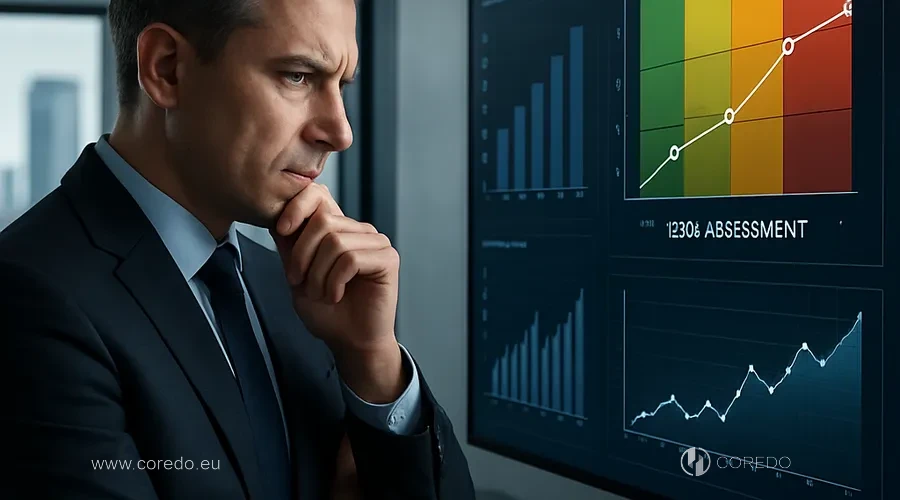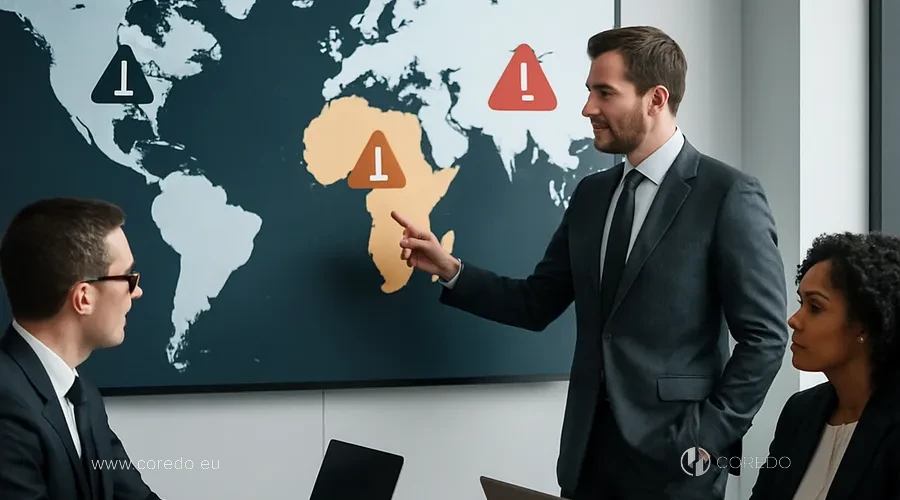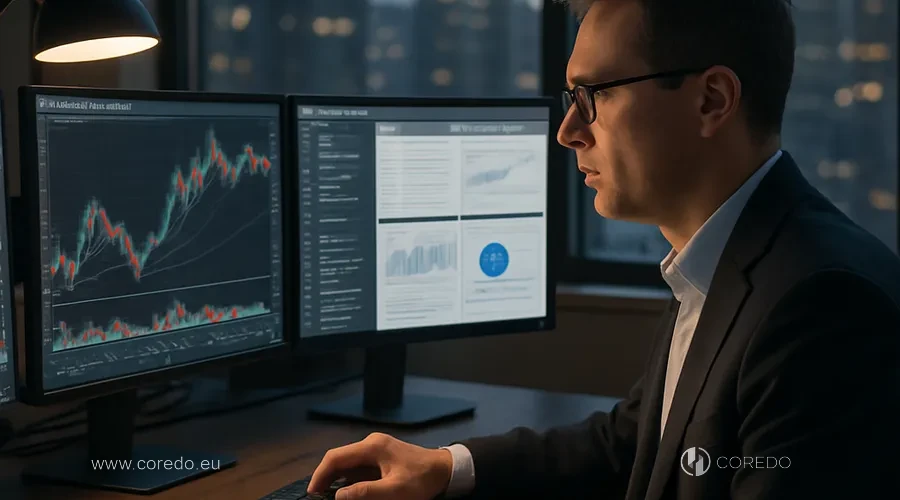Risk officer and risk management in the company

The risk officer plays a key role in ensuring effective risk management in a company, helping the business be resilient to external and internal threats and achieve strategic objectives. In today’s conditions of constant market changes, a competent approach to risk management and the professionalism of the risk officer become one of the factors of competitiveness and stability of the organization.
Who a risk officer is and their role in business
The risk officer is not just a controller but the architect of the company’s resilience. Their area of responsibility long ago went beyond formal compliance with standards: today the risk officer shapes the company’s risk management strategy, integrating compliance, internal audit and corporate security into a single system. In practice COREDO confirms: in international companies the role of the risk officer is especially significant when entering new markets, registering legal entities in the EU, the UK, Singapore or Dubai and obtaining licenses for financial and crypto operations.
In international business, the risk officer becomes a link between top management, the company’s legal support and external auditors. Their task is not only to identify and minimize operational, legal and cyber risks, but also to ensure process transparency for shareholders and regulators.
Risk management and enterprise risk management (ERM)
Effective risk management is built on the principles of enterprise risk management (ERM), where standards such as ISO 31000 and best GRC (Governance, Risk, Compliance) practices play a key role. According to COREDO’s experience, implementing ERM allows integrating risk assessment and monitoring into daily business processes, providing not only compliance with regulatory requirements but also increased operational efficiency.
In European and Asian companies, COREDO’s practice has shown that a systematic approach to risk management reduces the likelihood of legal disputes, account freezes and fines for violating AML/KYC procedures. Regular risk assessment, internal audit and process automation are basic elements of effective risk management that allow scaling the business without losing control.
Thus, modern risk management is unthinkable without the close integration of AML and compliance tools, which create a new set of tasks for the risk officer.
Impact of AML and compliance on the risk officer’s work
AML services for companies today are an integral part of the risk officer’s work, especially in the financial sector and when registering legal entities in the EU and Asia. Anti-money laundering legislation (AML) in Asia and Europe requires not only the implementation of formal procedures but also continuous transaction monitoring, staff training and interaction with regulators.
The solution developed at COREDO for clients entering the Singapore or Estonia markets includes comprehensive integration of AML/KYC procedures into business processes, which helps minimize the risk of account freezes and speeds up obtaining licenses. Implementing compliance control becomes a competitive advantage, allowing companies not only to meet requirements but also to build trust with international partners.
Key habits of effective risk officers

The key habits of effective risk officers form the foundation of a reliable risk management system in a company. Implementing these habits allows timely detection of threats and minimizing possible consequences, turning risk management into a proactive and systematic process.
Proactive identification and assessment of risks in work
An effective risk officer acts ahead of time: they do not wait for an incident but build a system of proactive risk identification and assessment. In COREDO’s practice this is implemented through regular risk assessment sessions, the introduction of early warning systems and the use of digital tools to monitor operational and cyber risks.
For example, when registering legal entities in the EU, the COREDO team implements risk assessment procedures at the Due Diligence stage, which allows identifying potential threats even before operations begin. This approach reduces the likelihood of legal conflicts and financial losses, especially when working in jurisdictions with increased AML control requirements.
Interaction with legal support and compliance
One of the key skills of a risk officer is effective communication with the company’s legal support and the compliance department. In practice, COREDO has implemented projects where the risk officer acted as a coordinator between external lawyers, internal auditors and top management, ensuring consistency of actions when registering companies in the United Kingdom, Slovakia and Dubai.
Effective collaboration not only allows for fast responses to changes in regulatory requirements, but also minimizes legal risks associated with entering new markets and obtaining financial licenses. It is important that the risk officer possesses up-to-date knowledge in international law, compliance standards and the specifics of AML control in different jurisdictions.
Professional training and skill development
The risk management market changes faster than internal regulations can be updated. Best practices in risk management for executives include regular training and the development of risk officers’ competencies — from studying new ISO 31000 standards to obtaining certifications in AML/KYC and digital security.
At COREDO, risk officer training is built on the principles of continuous development: participation in international conferences, exchange of experience with colleagues from Europe and Asia, and the implementation of new risk assessment and monitoring methodologies. This approach not only helps meet regulator requirements but also fosters a risk-aware culture within the company.
In current conditions, the development of risk competencies must go hand in hand with the adoption of innovative digital tools that open up new opportunities for automating risk management.
Automation of risk management with digital technologies
The impact of digital technologies on risk management cannot be overstated. automation of processes in risk management, the implementation of GRC systems and the use of analytics platforms for big data analysis allow the risk officer to focus on strategic tasks rather than routine checks.
COREDO’s practice confirms: the adoption of digital tools for transaction monitoring, cyber threat analysis and compliance automation reduces operational costs and increases the accuracy of risk assessment. This is especially relevant for companies operating in multiple jurisdictions and facing varying AML control requirements.
Risk management in Europe, Asia and Africa: practical tips

Risk management in Europe, Asia and Africa requires not only a standardized approach but also consideration of regional specifics that affect the effectiveness of measures and management tools. In current conditions, issues of AML control, responses to natural disasters and interaction with regulators gain particular importance, requiring comprehensive and practical solutions for business.
Risk management and AML control in Europe
Business risks in Europe are largely determined by the complexity of the regulatory environment and the diversity of requirements for AML/KYC procedures. Registration of legal entities in the EU requires a deep understanding of national and pan-European standards, regular interaction with regulators and the implementation of internal control systems.
In one of COREDO’s cases for a client opening a payment company in Estonia, a comprehensive approach was implemented: integration of AML services for companies, automation of transaction monitoring and staff training in compliance standards. This approach made it possible not only to obtain a license but also to build long-term relationships with banks and auditors.
Anti-money laundering legislation and compliance in Asia
Anti-money laundering legislation (AML) in Asia is characterized by a high pace of change and an emphasis on digital client identification procedures. Successful registration and licensing of legal entities in Singapore or Hong Kong requires not only the implementation of AML/KYC procedures but also the constant updating of internal policies in accordance with local regulators’ requirements.
The COREDO team supported the implementation of AML programs in CIS companies entering Southeast Asian markets. Special attention was paid to the specifics of AML control in different jurisdictions, the integration of digital platforms for transaction monitoring and training employees to work with new standards.
Legal risks and risk management in Africa
African markets attract international business with high growth potential but require a special approach to managing legal risks and scaling risk management. Strategies to minimize legal risks in Africa include deep due diligence of partners, adapting compliance processes to local specifics and implementing early warning systems.
COREDO’s experience has shown: for transnational companies it is critical to scale risk management processes using centralized GRC systems and digital tools for risk analysis. This approach ensures transparency and controllability even when operating in regions with high volatility of political and economic factors.
Risk officer effectiveness metrics

Risk officer effectiveness metrics not only make it possible to measure the results of risk management work, but also provide transparency of processes for company leadership. It is through such indicators that it becomes possible to objectively assess how timely and effectively risk reduction strategies are being implemented, and whether the company aligns with its stated business goals and acceptable risk levels.
Thus, the use of effective metrics creates the basis for moving on to consider key indicators in the field of risk management.
KPI and ROI in risk management – main indicators
The effectiveness of a risk officer cannot be assessed without clear KPIs and ROI metrics. In practice, COREDO uses the following indicators:
- Share of risks identified and eliminated before an incident
- Response time to incidents and regulatory requests
- Number of successfully completed checks and audits
- ROI from implementing AML programs (reduction of fines, faster licensing, increased partner trust)
- Level of automation of risk management processes
The table presents the main metrics for assessing the effectiveness of risk management
to the officer:
| Metric | Description and business value |
|---|---|
| Percentage of incidents prevented | Demonstrates proactivity and effectiveness |
| Risk response time | An important indicator of process maturity |
| ROI from AML programs | Measures the economic impact of implementation |
| Number of trained employees | Affects risk culture and resilience |
| Level of automation | Shows the maturity level of risk management |
Implementing GRC systems and internal audit
Implementing GRC systems (Governance, Risk, Compliance) allows integrating risk management, compliance, and internal audit into a single digital platform. This approach ensures process transparency, automated reporting, and effective internal control.
COREDO’s practice has shown: companies using modern GRC systems undergo regulatory inspections faster, minimize human error and increase ROI from risk management. Internal audit becomes not a formality but a tool for strategic development.
Automation tools and digital technologies to increase efficiency
A modern risk officer uses digital tools for big data analysis, transaction monitoring and compliance automation. Among the most effective solutions are AI-based systems for anomaly detection, platforms for automated KYC, and tools for cyber risk assessment.
Implementing such solutions at COREDO allowed clients to reduce operational costs, speed up the company registration processes in the EU and Asia, and increase transparency for regulators and partners.
How to improve the effectiveness of a risk officer?

Improving a risk officer’s effectiveness is only possible with a systemic approach to risk management and the formation of an appropriate corporate culture. The degree of protection against unforeseen losses and success in achieving strategic goals depends on how well the processes for risk identification, analysis, and communication are arranged.
Risk culture development and risk management in the company
Building a risk culture is a key factor for long-term resilience. An effective risk officer does not limit themselves to implementing procedures but builds a risk management strategy, integrating it into the corporate culture and the company’s strategic planning.
The COREDO team has implemented projects where introducing a risk culture reduced the number of incidents and increased employee engagement in compliance processes. This approach not only minimizes legal and operational risks but also enhances business competitiveness.
Interaction with regulators and auditors
Open and professional interaction with regulators and auditors is the key to successful inspections and obtaining licenses. A risk officer should not only know regulatory requirements but also be able to argue the company’s position and build trusting relationships with external auditors and legal partners.
COREDO’s practice confirms: process transparency, timely updates of internal policies, and regular staff training help minimize a risk officer’s legal liability and reduce the likelihood of sanctions.
Managing personnel risks in the risk management team
Personnel risks in risk management teams are often underestimated. An effective risk officer builds a system of training and competency development, and implements mechanisms of internal control and employee motivation.
At COREDO, special attention is paid to forming multidisciplinary teams where AML, compliance, and legal support experts work closely together. This approach allows for rapid response to changes in regulatory requirements and ensures process resilience even amid high staff turnover.
Early warning systems and risk monitoring
Early warning systems for risks are not only digital tools but also organizational practices that allow threats to be identified at early stages. An effective risk officer implements regular monitoring of key indicators, analyzes external and internal data, and initiates corrective actions before an incident occurs.
Solutions developed at COREDO include integrating early warning systems into due diligence processes, AML monitoring, and strategic planning. This approach ensures flexibility and adaptability to rapidly changing market conditions.
Key conclusions and recommendations for entrepreneurs
- An effective risk officer is a strategic business partner, integrating compliance, AML, and legal support into a unified risk management system.
- Key habits: proactive risk identification, continuous learning, use of digital technologies, effective communication with legal and compliance departments.
- To assess effectiveness use KPIs: percentage of incidents prevented, ROI from AML programs, level of automation and employee engagement.
- Implement GRC systems, develop a risk culture, and provide regular team training.
- When choosing a risk officer and legal partner, pay attention to experience in international jurisdictions, knowledge of regulatory requirements in the EU, Asia, and Africa, and the ability to scale risk management processes.
- To minimize risks when registering legal entities internationally and obtaining financial licenses, integrate AML/KYC procedures, automate compliance, and build open interaction with regulators.
COREDO’s practice confirms: only a comprehensive, strategic, and technological approach to risk management allows not only meeting requirements but also turning risk management into a source of sustainable growth and trust in international markets.